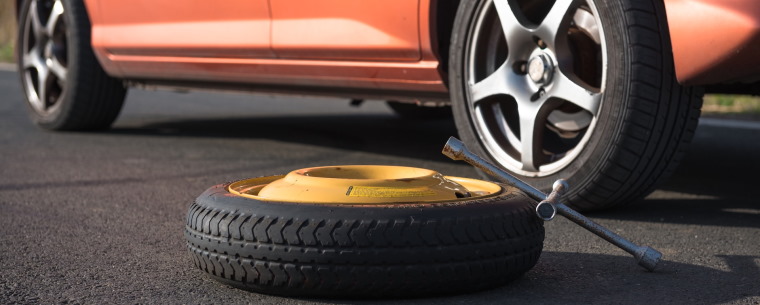Spare Tyres: What You Need to Know
Jack Dreyer | Thursday 28th April 2022 11:00am

Spare tyres are essential for every car owner. They ensure safety and security and save you from spending extra money on repairs.
However, replacing your tyre isn't as simple as just pulling it out of your boot and placing it on. To ensure your vehicle is safe and roadworthy with a spare tyre, there are a few things you need to do first.
Maintaining your spare tyre
Maintenance is key. To keep your spare tyre in tip-top condition, youíll need to check it regularly. If your spare tyre is a doughnut, maintenance is especially important. Here are the most crucial things you should be checking:
Pressure
Tyre pressure should be checked regularly. If the pressure drops below the recommended level, then the tyre is underinflated. This could result in reduced performance and increased fuel consumption. The average spare tyre should have a pressure of 60 pounds per square inch (PSI).
You can find out how to check your tyre pressures with another of our blogs here.
Rotate your spare
All tyres should be rotated often (between six to eight thousand miles) and that includes spares, too - especially if youíll be using it for a while.
By rotated, we mean that the tires should shift position around the vehicle, i.e. the rear left becomes the front left, the front left becomes the front right, the front right becomes the back right, and the back right becomes the back left.
Check the age and condition of your tyre
The age of a tyre can tell you whether it needs replacement. Older tyres tend to wear down faster than newer ones. In general, older tyres will have less grip, so make sure that you replace them before they become unsafe.
If you don't want to buy new tyres, then you can use an indicator gauge to determine when it's time to change your tyres. These indicators are usually placed inside the wheel well, but some cars may not have them. Check with your local garage to see what type of indicators they sell. If you're unsure about the condition of your tyres, get in touch with the experts at your nearest Kwik Fit centre. They'll be able to give you more information about their condition.
Keep a puncture repair kit
Remember: one of the most important things you can do is to keep a puncture repair kit to hand. Puncture repair kits contain all the tools you'll need to fix punctures quickly. These include an air compressor, sealant, patch kit, wheel brace, and jack.
Ensure that you have these items in your boot wherever you go; if your spare tyre packs out, you may just be able to mend it yourself.
Check itís the right fit
Before you start installing your spare tyre, check itís the right fit for your vehicle. Some vehicles come with different sizes of spares, so make sure you get the correct one for your model.
In most cases, you can check the model of your spare tyre by looking at the side of the wheel well. Most models will have a sticker or label which tells you this information.
How long can you drive a spare tyre for?
Thereís no set answer to this question. A good rule of thumb is to drive your spare tyre for around 50 miles, at a maximum speed of 50mph. Most spares have a limited tread, so this way, you won't run into any problems. However, if you plan on travelling long distances, it's best to carry a second set of wheels.
Stay safe out there
Remember: your spare tyre wonít have the same amount of wear as your other tyres. This could impact driving performance and put you in danger out on the roads. Maintaining your spare tyre as often as possible will keep you, and others, safe.
If you have any questions about your spare tyres or regular tyres, contact our team of expert technicians today.
Any facts, figures and prices shown in our blog articles are correct at time of publication.
Featured Articles
Is it Illegal to Drive With One Headlight?
Saturday 19th July 2025
Wondering if itís illegal to drive with one headlight? Learn about the safety risks and penalties of illegal blown bulbs and why you should fix them promptly.
Air Con in EVs & Hybrids: Experts Answer Your Questions
Monday 30th June 2025
Does air con drain EV batteries? Can you use the air con while charging an electric car? Find out the answers to these questions & more from Kwik Fitís experts.
Why Is Your Car Making a Noise? Fixes & Tips
Friday 13th June 2025
When your car starts making unexpected noises, it can certainly be quite disconcerting; it may be nothing to worry about, but hereís what you need to know.









